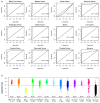A Novel Blood-Based microRNA Diagnostic Model with High Accuracy for Multi-Cancer Early Detection
- PMID: 35326599
- PMCID: PMC8946599
- DOI: 10.3390/cancers14061450
A Novel Blood-Based microRNA Diagnostic Model with High Accuracy for Multi-Cancer Early Detection
Abstract
Early detection is critical to reduce cancer deaths as treating early stage cancers is more likely to be successful. However, patients with early stage diseases are often asymptomatic and thus less likely to be diagnosed. Here, we utilized four microarray datasets with a standardized platform to investigate comprehensive microRNA expression profiles from 7536 serum samples. A 4-miRNA diagnostic model was developed from the lung cancer training set (n = 416, 208 lung cancer patients and 208 non-cancer participants). The model showed 99% sensitivity and specificity in the lung cancer validation set (n = 3328, 1358 cancer patients and 1970 non-cancer participants); and the sensitivity remained to be >99% for patients with stage 1 disease. When applied to the additional combined dataset of 3792 participants including 2038 cancer patients across 12 different cancer types and 1754 independent non-cancer controls, the model demonstrated high sensitivities ranging from 83.2 to 100% for biliary tract, bladder, colorectal, esophageal, gastric, glioma, liver, pancreatic, and prostate cancers, and showed reasonable sensitivities of 68.2 and 72.0% for ovarian cancer and sarcoma, respectively, while maintaining 99.3% specificity. Our study provided a proof-of-concept data in demonstrating that the 4-miRNA model has the potential to be developed into a simple, inexpensive and noninvasive blood test for early detection of multiple cancers with high accuracy.
Keywords: blood-based diagnostic model; microRNA; multi-cancer early detection; noninvasive.
Conflict of interest statement
H.H. is a cofounder of miRoncol Diagnostics, a company that seeks to commercialize the diagnostic model.
Figures



Similar articles
-
Noninvasive multi-cancer detection using blood-based cell-free microRNAs.Sci Rep. 2024 Sep 27;14(1):22136. doi: 10.1038/s41598-024-73783-0. Sci Rep. 2024. PMID: 39333750 Free PMC article.
-
MicroRNA markers for the diagnosis of pancreatic and biliary-tract cancers.PLoS One. 2015 Feb 23;10(2):e0118220. doi: 10.1371/journal.pone.0118220. eCollection 2015. PLoS One. 2015. PMID: 25706130 Free PMC article.
-
Preliminary evaluation of miR-1307-3p in human serum for detection of 13 types of solid cancer using microRNA chip.Heliyon. 2021 Sep 2;7(9):e07919. doi: 10.1016/j.heliyon.2021.e07919. eCollection 2021 Sep. Heliyon. 2021. PMID: 34541347 Free PMC article.
-
Evaluating the Use of Circulating MicroRNA Profiles for Lung Cancer Detection in Symptomatic Patients.JAMA Oncol. 2020 May 1;6(5):714-723. doi: 10.1001/jamaoncol.2020.0001. JAMA Oncol. 2020. PMID: 32134442 Free PMC article.
-
Clinical use of microRNAs as potential non-invasive biomarkers for detecting non-small cell lung cancer: a meta-analysis.Respirology. 2015 Jan;20(1):56-65. doi: 10.1111/resp.12444. Epub 2014 Dec 1. Respirology. 2015. PMID: 25440223 Review.
Cited by
-
Noninvasive multi-cancer detection using blood-based cell-free microRNAs.Sci Rep. 2024 Sep 27;14(1):22136. doi: 10.1038/s41598-024-73783-0. Sci Rep. 2024. PMID: 39333750 Free PMC article.
-
Identifying potential circulating miRNA biomarkers for the diagnosis and prediction of ovarian cancer using machine-learning approach: application of Boruta.Front Digit Health. 2023 Aug 9;5:1187578. doi: 10.3389/fdgth.2023.1187578. eCollection 2023. Front Digit Health. 2023. PMID: 37621964 Free PMC article.
-
Biomarkers in Cancer Screening: Promises and Challenges in Cancer Early Detection.Hematol Oncol Clin North Am. 2024 Aug;38(4):869-888. doi: 10.1016/j.hoc.2024.04.004. Epub 2024 May 22. Hematol Oncol Clin North Am. 2024. PMID: 38782647 Free PMC article. Review.
-
Genomic and Transcriptomic Research in the Discovery and Application of Colorectal Cancer Circulating Markers.Int J Mol Sci. 2023 Aug 3;24(15):12407. doi: 10.3390/ijms241512407. Int J Mol Sci. 2023. PMID: 37569782 Free PMC article. Review.
-
Multi-cancer Detection Using Pattern Formation in Drying Body Fluids: A Systematic Review and Meta-Analysis of Diagnostic Test Accuracy Studies.Technol Cancer Res Treat. 2025 Jan-Dec;24:15330338251333994. doi: 10.1177/15330338251333994. Epub 2025 Sep 1. Technol Cancer Res Treat. 2025. PMID: 40888601 Free PMC article.
References
-
- Noone A.M., Howlader N., Krapcho M., Miller D., Brest A., Yu M., Ruhl J., Tatalovich Z., Mariotto A., Lewis D.R., et al. SEER Cancer Statistics Review, 1975–2015. National Cancer Institute; Rockville, MD, USA: 2018.
LinkOut - more resources
Full Text Sources
Other Literature Sources

